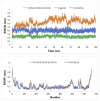Cimicifugoside H-2 as an Inhibitor of IKK1/Alpha: A Molecular Docking and Dynamic Simulation Study
- PMID: 39062574
- PMCID: PMC11274867
- DOI: 10.3390/biom14070860
Cimicifugoside H-2 as an Inhibitor of IKK1/Alpha: A Molecular Docking and Dynamic Simulation Study
Abstract
One of the most challenging issues scientists face is finding a suitable non-invasive treatment for cancer, as it is widespread around the world. The efficacy of phytochemicals that target oncogenic pathways appears to be quite promising and has gained attention over the past few years. We investigated the effect of docking phytochemicals isolated from the rhizomes of the Cimicifuga foetida plant on different domains of the IκB kinase alpha (IKK1/alpha) protein. The Cimicifugoside H-2 phytochemical registered a high docking score on the activation loop of IKK1/alpha amongst the other phytochemicals compared to the positive control. The interaction of the protein with Cimicifugoside H-2 was mostly stabilized by hydrogen bonds and hydrophobic interactions. A dynamic simulation was then performed with the Cimicifugoside H-2 phytochemical on the activation loop of IKK1/alpha, revealing that Cimicifugoside H-2 is a possible inhibitor of this protein. The pharmacokinetic properties of the drug were also examined to assess the safety of administering the drug. Therefore, in this in silico study, we discovered that the Cimicifugoside H-2 phytochemical inhibits the actively mutated conformation of IKK1/alpha, potentially suppressing the nuclear factor kappa light chain enhancer of activated B cells (NF-κB) pathway.
Keywords: Cimicifugoside H-2; IKK1/alpha or IKK1/α; NF-κB pathway; dynamic simulation; molecular docking.
Conflict of interest statement
The authors report no conflicts of interest.
Figures






References
MeSH terms
Substances
LinkOut - more resources
Full Text Sources
Miscellaneous

